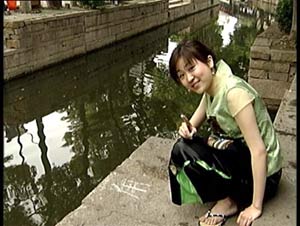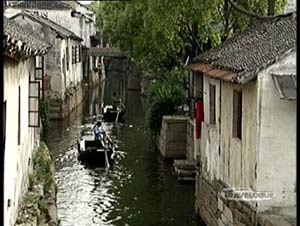Another day, another town--Luzhi.

That spirit up there, his name is 'Lu duan.' The story is that a long time ago, 'Lu Duan' came to this ancient water town and realized what a wonderful place this was. He decided to stay and the town is named 'Luzhi' after him. Maybe that's just a story, but to find out the real story behind Luzhi, we have to take a look at the ancient water town.
Luzhi is about 25km east of Suzhou, between Suzhou city and Shanghai. The town is only one square km, but the natural beauty is indescribable, with still waters, stone bridges and ancient dwellings, as well as a few sites of cultural significance.

Luzhi is famous for its bloodline, that is, the water. From a birds eye view, even the town looks like the Chinese character 'Lu' because of the horizontal and vertical intersection of water paths.
This is the first character in the name of this town, Lu, and this character is only used only in one context, and that's the name of this town. If you take a good look, the character sort of looks like the town itself. This is the main waterway the river that branches out into three tiny waterways over here, three going from left to right.
The locals seem to live a tranquil, simple life. The main means of transportation is still by boats that row through the water.
The water lanes serve as roads, and the banks of the river are laid with stones that serve as simple docks for people to embark or disembark or to simply fetch water.
You know, my steps are not big, but it only took three to get from the bridge over there to this new one over here. That just show close they are. In fact this place has the most number of bridges by area in the world. And for their number and their beauty, it's known as the Venice of the East.
Luzhi has been reputed as A Land of Bridges for long. It is amazing to see so many famous small bridges span the merely 5 or 6-kilometer-long river course, some that date back as early as the Song dynasty in the 10th century. At some point, the town had 72.5 bridges, but now 40 some remain. Stone bridges with several arches, one arch, wide and narrow flat-top bridges, sister bridges and so on. All theses densely built bridges make Luzhi quite unique amongst the water towns.
On the sides of the water, you might also notice the boat ties. They are used to secure the position of the boat and are designed in many shapes and sizes. They are a perfect mix of functionality and art.
In the water town, boats are the only means of transportation. They are like our modern day cars, but maybe a bit slower.
Slower, but much smoother.
But for those who chose another means to travel, you can walk along the ceilinged corridors to get to your destination by the water. If you're not in a hurry, though, you can watch the locals get about their daily business in this center of activity. Th ceilinged corridors keep us fro the rain, allow us to visit some of the shops along this path.

